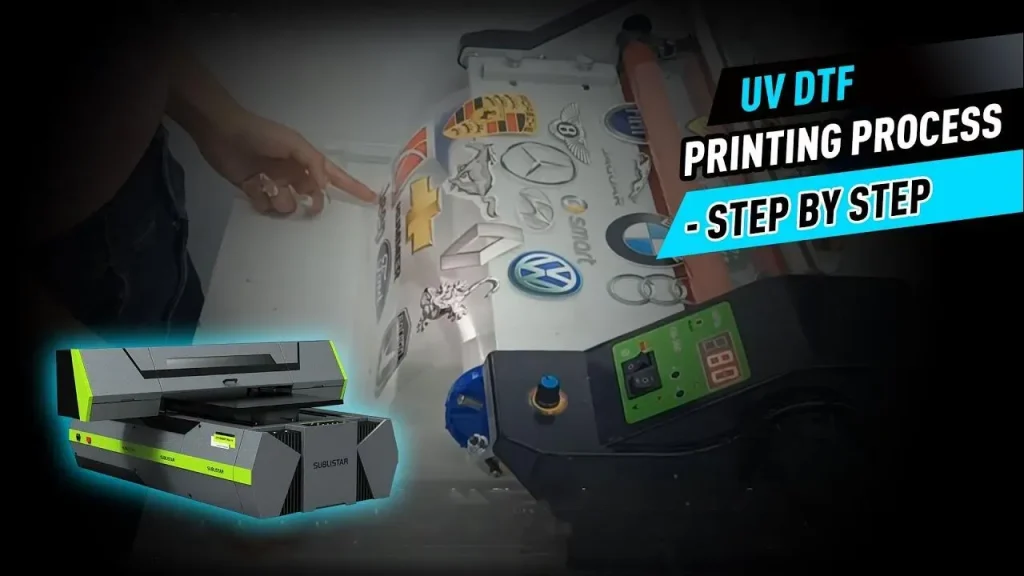UV DTF printing techniques represent a groundbreaking advancement in the printing industry, merging the strengths of both UV printing and direct to film (DTF) processes. This innovative approach allows for the creation of dazzling prints on a wide array of substrates, from textiles to metals, making it a valuable option for businesses and creatives alike. Utilizing UV-curable inks, this method ensures vibrant colors and exceptional durability, key attributes for high-quality prints. As consumers increasingly demand personalized products, UV DTF printing emerges as a versatile solution ideal for both promotional and artistic endeavors. This guide will delve into the exciting possibilities offered by UV DTF printing techniques, highlighting their applications and benefits to inspire both novice and seasoned professionals.
Exploring the realm of direct to film printing methods, particularly through UV technologies, unveils a plethora of opportunities for customization and creativity. Known for its ability to produce stunning graphics on diverse UV printable materials, this approach offers a quick turnaround and unparalleled durability in prints. By harnessing the power of ultraviolet light, direct to film processes can elevate standard printing to a whole new level, perfect for signage and personalized items alike. With an increasing number of applications in various sectors, from fashion to promotional merchandise, understanding these advanced printing techniques can significantly enhance product offerings. As the demand for high-quality, long-lasting prints grows, those leaning towards UV printing applications will find countless ways to innovate and captivate their audience.
Understanding UV DTF Printing Basics
UV DTF printing stands out as a breakthrough in the printing industry, merging the benefits of UV technology with the versatility of DTF methods. At its core, this process uses UV-curable inks that dry through exposure to ultraviolet light, allowing for a more robust and vibrant outcome. The films used in this method are designed to carry the ink, which can then be easily transferred to various materials, making it incredibly adaptable for different printing needs.
As a beginner, understanding what sets UV DTF apart from traditional printing methods is crucial. Unlike conventional printing, where inks tend to seep into the substrate, UV printing applies a thin layer that bonds well to the film, enhancing color vibrancy and durability. This characteristic makes UV DTF an attractive option for many applications, from textiles to hard surfaces, linking creativity with advanced technology.
The Advantages of Using UV DTF Printing Techniques
One of the primary advantages of UV DTF printing techniques is the high level of durability offered by UV inks. Once cured, these prints exhibit incredible resistance to environmental factors such as water, UV rays, and even abrasion, which is essential for products exposed to outdoor conditions. This quality minimizes the risk of fading or wear, thus ensuring that printed items retain their vibrancy over time.
Moreover, the quick curing process enables immediate handling of printed items, eliminating the waiting period associated with traditional printing methods. This rapid production allows businesses to meet tight deadlines while maintaining high-quality output. Additionally, the versatility of substrates compatible with UV DTF printing expands the potential applications significantly, making it a cost-effective and efficient method for artisans and companies alike.
Applications of UV DTF Printing in Various Industries
UV DTF printing technology is making significant waves across various industries, particularly in promotional products. Its ability to create high-resolution designs makes it perfect for items like branded mugs and coasters that require detailed graphics to boost visibility and brand identity. The vibrant imagery printed with UV DTF techniques enhances marketing campaigns and provides a memorable experience for customers.
Furthermore, the textile industry benefits from UV DTF printing as well, with apparel customization gaining popularity among retailers looking to stand out in a saturated market. The durability of UV ink ensures that designs withstand numerous washes, making it an ideal choice for fashion brands aiming for longevity in their products. Beyond promotional items and clothing, the method is also increasingly used for creating signage that remains resilient in outdoor settings, proving its versatility.
Considerations for Beginners in UV DTF Printing
For those venturing into UV DTF printing, selecting the right equipment is a critical first step. High-quality printers capable of handling UV inks and the DTF process effectively are necessary for achieving excellent results. Beginners should seek out well-reviewed printer models to ensure lasting performance and consistency in print quality.
Additionally, understanding substrate compatibility is vital. Not all materials will adhere well to UV DTF prints, so it’s essential to research and test various substrates. Some surfaces may require special treatments like primers, while others may not be suitable at all. Being well-informed about these factors will help prevent wasted time and resources, setting the foundation for a successful printing venture.
The Technology Behind UV Printing Techniques
The technology at the heart of UV DTF printing hinges on UV-curable inks, which are formulated with photoinitiators. These compounds allow the ink to cure almost instantaneously when exposed to UV light, resulting in fast production times and high-quality prints. This process not only improves workflow efficiency but also enhances color vibrancy, offering a broader color gamut and sharper details in graphics.
Moreover, the direct-to-film aspect of this technology is particularly notable as it allows for the application of prints on a variety of surfaces, which is crucial for targeted marketing and personalized products. The versatility of UV printable materials—ranging from textiles to plastics—opens new avenues for creativity in design and application, leading to exciting possibilities for both businesses and individual creators.
Maintaining Your UV DTF Printing Equipment
Regular maintenance is paramount in the world of UV DTF printing to ensure the longevity and efficiency of your equipment. Dust and residue can accumulate on the printing surfaces, which may affect performance and print quality. Implementing a routine maintenance schedule, including cleaning print heads and checking ink cartridges, can help mitigate these issues and maintain optimal operation.
Following manufacturer guidelines for your specific printer model regarding upkeep and care is equally essential. This practice not only prolongs printer life but also supports consistent quality in your prints. Being proactive with maintenance can minimize operational costs while maximizing the output quality, allowing you to focus more on creativity and less on equipment issues.
Frequently Asked Questions
What are the key advantages of UV DTF printing techniques over traditional methods?
UV DTF printing techniques offer several advantages, including durable prints that withstand environmental exposure, immediate handling post-curing, and versatile applications across various substrates. Unlike traditional printing that requires drying time, UV DTF prints are ready to use right after curing, making them cost-effective and efficient for businesses.
How does the UV printing process work in UV DTF printing techniques?
In UV DTF printing techniques, UV-curable inks are printed onto a special film and cured using ultraviolet light. This curing process solidifies the ink almost instantly, resulting in vibrant colors and exceptional durability. The direct-to-film aspect allows for easy transfer of designs onto various materials, enhancing the printing versatility.
What materials are compatible with UV DTF printing techniques?
UV DTF printing techniques are compatible with a wide range of materials, including textiles, wood, metal, and hard plastics. It’s important to ensure that the chosen substrate is suitable for UV printing applications, as some materials may require a primer for better ink adhesion.
Can UV DTF printing be used for personalized products?
Yes, UV DTF printing techniques are ideal for creating personalized products. This printing method allows for unique designs to be applied to various surfaces, catering to individual customer preferences, whether for personalized gifts, apparel, or promotional items.
What should beginners consider when starting with UV DTF printing techniques?
Beginners should consider factors like investing in high-quality UV printers, understanding substrate compatibility for optimal results, and being aware of the learning curve associated with operating the equipment. Regular maintenance and cleaning of printers are also crucial for longevity and consistent print quality.
How is the UV DTF printing market currently trending?
The UV DTF printing market is expanding significantly as more businesses recognize its efficiency and durability. Trends include the adoption of eco-friendly inks and reduced energy consumption in the curing processes, reflecting a growing emphasis on sustainability within the industry.
| Key Points | Details |
|---|---|
| What is UV DTF Printing? | A printing technique that combines UV printing technology with DTF methods to create vibrant prints on various substrates. |
| Technology Behind UV DTF Printing | Uses UV-curable inks that cure quickly under UV light, allowing for high-resolution and durable prints. |
| Advantages | Durable prints, immediate handling, versatile applications, and cost-effective production make UV DTF printing appealing. |
| Applications | Promotional products, apparel, signage, and personalization are all ideal uses for UV DTF printing. |
| Considerations for Beginners | Focus on equipment quality, substrate compatibility, learning curves, and maintenance. |
| Market Trends | The market is expanding with eco-friendly inks and energy-efficient curing processes being developed. |
Summary
UV DTF printing techniques represent a breakthrough in modern printing, combining the best of UV and DTF printing methods to achieve striking visual results. This innovative technique not only delivers exceptional print quality but also offers a high degree of durability across various substrates. As businesses and individuals continue to explore the potential of UV DTF printing techniques, they can create eye-catching promotional products, custom apparel, and robust signage that withstands the elements. With the right equipment and understanding of the process, anyone can master these techniques to elevate their design offerings and engage customers with versatile and personalized options.



